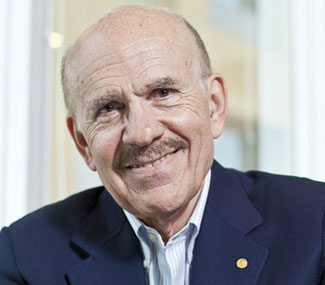
Louis Ignarro spent the first two decades of his life in Long Beach, New York City where his family settled after immigrating from Italy in the 1920s. During his youth, he enjoyed building enormous sand castles, and all of his friends predicted he would become an engineer or architect. Early in his life, his parents bought him a coveted chemistry set, and he loved conducting successful experiments. Ignarro eventually went on to study Pharmacy and Chemistry at Columbia University in New York City.
Throughout his undergraduate years, he contemplated a career of rebuilding race cars at the West Hampton Drag Raceway, until he decided instead to apply and attend graduate school at the University of Minnesota for Pharmacology.
While working on his thesis, Ignarro submitted four separate manuscripts on his research to the Journal of Pharmacology and Experimental Therapeutics, which accepted all his work and published them back-to-back in a single issue of the journal, which had never been done before.
When Ignarro moved to New Orleans to continue intensive research, he took a deeper look into blood vessels after reading a compelling article by Ferid Murad and fellow researchers.
Ignarro himself wrote:
Nitroglycerin was one of those nitro compounds that Ferid had studied and speculated might release nitric oxide which then activated guanylate cyclase. It occurred to me that nitric oxide might account for the vascular smooth muscle relaxing action of nitroglycerin and that cyclic GMP might be the second messenger responsible for mediating the vasorelaxant effect of nitric oxide. In 1979 we published the first account of the capacity of nitric oxide to relax vascular smooth muscle. We purchased a small cylinder of nitric oxide gas, made a dilution in nitrogen (nitric oxide is very unstable in the presence of oxygen), and injected a fine stream of gas bubbles into an organ bath in which was mounted a strip of bovine coronary artery precontracted by addition of phenylephrine. The result was a rapid and profound relaxation of the coronary artery strip. This vasorelaxant effect of nitric oxide was blocked by addition of hemoglobin, which promotes oxidation of nitric oxide, and methylene blue, which had been known to inhibit guanylate cyclase. And so we knew right away that nitric oxide was probably responsible for the vasorelaxant effect of nitroglycerin and that cyclic GMP was the likely ultimate mediator of relaxation, just as Ferid Murad had predicted.
For more information on the work that resulted in Louis J. Ignarro and two other American scientists being awarded the Nobel Prize in the Physiology of Medicine in 1998, see www.nobelprize.org/prizes/medicine/1998/ignarro/facts/
